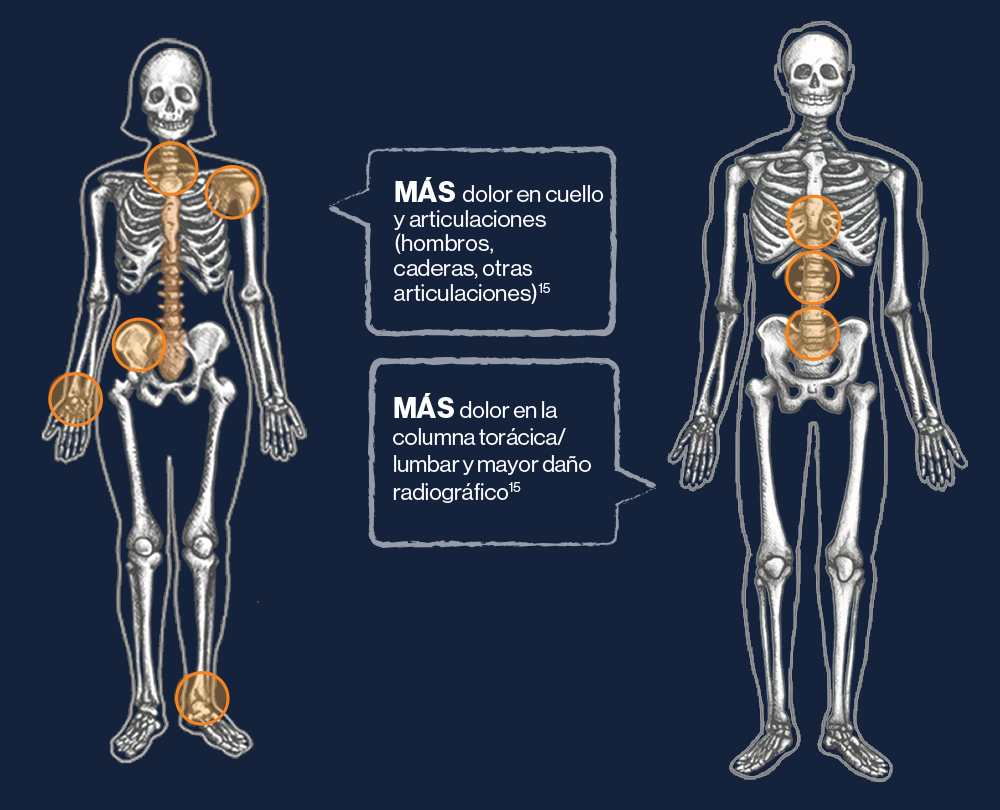La EspAax-nr:
|
Afecta en mayor proporción a las mujeres7 |
Se suele diagnosticar más tarde en las mujeres que, a menudo, presentan una progresión menor o más lenta de los daños radiográficos que los hombres, incluso tras sufrir síntomas7,13 |
|
A pesar de no presentar daños visibles en radiografías convencionales, conlleva una carga de síntomas similar a la EA7,13 |
|
La EspAax tiene una presentación diferente en mujeres y hombres:
Las mujeres y los hombres con EspAax pueden presentar grupos de síntomas diferentes; por ejemplo, las mujeres presentan más dolor en articulaciones periféricas que los hombres.*15

**Los participantes de este estudio habían recibido un diagnóstico de EA.15
Con un mayor retraso diagnóstico, más dolor en articulaciones periféricas y menor evidencia de daño radiográfico3,7,13,15, no es sorprendente que muchas mujeres con EspAax-nr sigan sin conocer cuál es la causa de sus síntomas.
|
Cuando evalúes a mujeres menores de 45 años de edad que empiezan a mostrar dolor lumbar inflamatorio y dolor nocturno, piensa si pueden tener EspAax-nr.
|
EA: espondilitis anquilosante; EspAax: espondiloartritis axial; EspAax-nr: espondiloartritis axial no radiográfica.
|
|
|
Referencias:
1. Rudwaleit M, et al. The development of Assessment of SpondyloArthritis International Society classification criteria for axial spondyloarthritis (part II): validation and final selection. Ann Rheum Dis. 2009;68:777–783; 2. Protopopov M, Poddubnyy D. Radiographic progression in non-radiographic axial spondyloarthritis. Expert Rev Clin Immunol. 2018;14:525–533; 3. Mease PJ, et al. Characterization of patients with ankylosing spondylitis and nonradiographic axial spondyloarthritis in the US-based Corrona Registry. Arthritis Care Res (Hoboken). 2018;70:1661–1670; 4. Strand V, Singh JA. Evaluation and management of the patient with suspected inflammatory spine disease. Mayo Clin Proc. 2017;92:555–564; 5. Kiltz U, et al. Do patients with non-radiographic axial spondylarthritis differ from patients with ankylosing spondylitis? Arthritis Care Res (Hoboken). 2012;64:1415–1422; 6. Malaviya AN, et al. Comparison of patients with ankylosing spondylitis (AS) and non-radiographic axial spondyloarthritis (nr-axSpA) from a single rheumatology clinic in New Delhi. Int J Rheum Dis. 2015;18:736–741; 7. Boonen A, et al. The burden of non-radiographic axial spondyloarthritis. Semin Arth Rheum. 2015;44:556–562; 8. Rudwaleit M, et al. The challenge of diagnosis and classification in early ankylosing spondylitis: do we need new criteria? Arthritis Rheum. 2005;52:1000–1008; 9. Sieper J, et al. Axial spondyloarthritis. Nat Rev Dis Primers. 2015;1:15013; 10. Vidal C, et al. Poor efficacy of TNF inhibitors in non-radiographic axial spondyloarthritis in the absence of objective signs: a bicentric retrospective study. Joint Bone Spine. 2018;85:461–468; 11. Chakrabarty S, Zoorob R. Fibromyalgia. Am Fam Physician. 2007;76:247–254; 12. Sieper J, Rudwaleit M. Early referral recommendations for ankylosing spondylitis (including pre-radiographic and radiographic forms) in primary care. Ann Rheum Dis. 2005;64:659–663; 13. Rusman T, et al. Gender differences in axial spondyloarthritis: women are not so lucky. Curr Rheumatol Rep. 2018;20:35; 14. Baraliakos X, et al. Patients with fibromyalgia rarely fulfil classification criteria for axial spondyloarthritis. Rheumatology (Oxford). 2018;57:1541–1547; 15. Lee W, et al. Are there gender differences in severity of ankylosing spondylitis? Results from the PSOAS cohort. Ann Rheum Dis. 2007;66:633–638.

